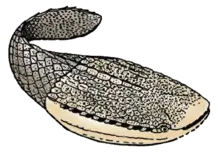Prioniodontida
Prioniodontida, also known as the "complex conodonts", is a large clade of conodonts that includes two major evolutionary grades; the Prioniodinina and the Ozarkodinina.[2] It includes many of the more famous conodonts, such as the giant ordovician Promissum (Prioniodinina) from the Soom Shale[3] and the Carboniferous specimens from the Granton Shrimp bed (Ozarkodinina).[4] They are euconodonts, in that their elements are composed of two layers; the crown and the basal body, and are assumed to be a clade.
| Prioniodontida ("Complex conodonts") | |
|---|---|
| Scientific classification | |
| Kingdom: | Animalia |
| Phylum: | Chordata |
| Class: | †Conodonta |
| Clade: | †Euconodonta |
| Clade: | †Prioniodontida Dzik, 1976[1] |
| Orders | |
|
See text | |
Phylogeny
This is a recent cladogram of the Prioniodontida, simplified from Donoghue et al., (2008).[2]
| Prioniodontida |
| |||||||||||||||||||||||||||||||||||||||
Notes
- Bactrognathidae is actually only one of two families (the other unnamed) belonging to a superfamily that is as yet unnamed.
References
- Remarks on the evolution of Ordovician conodonts. J Dzik, Acta Palaeontologica Polonica, 1976, volume 21, no 4 (pdf, retrieved 30 April 2016)
- Donoghue, P.C.J.; Purnell, M.A.; Aldridge, R.J.; Zhang, S. (2008). "The interrelationships of 'complex' conodonts (Vertebrata)". Journal of Systematic Palaeontology. 6 (2): 119–153. doi:10.1017/s1477201907002234.
- Gabbott, S.E.; Aldridge, R.J.; Theron, J.N. (1995). "A giant conodont with preserved muscle tissue from the Upper Ordovician of South Africa". Cite journal requires
|journal=(help) - Briggs, D.E.G; Clarkson, E.N.K.; Aldridge, R.J. (1983). "The conodont animal". Lethaia. 16 (1): 1–14. doi:10.1111/j.1502-3931.1983.tb01993.x.
External links
This article is issued from Wikipedia. The text is licensed under Creative Commons - Attribution - Sharealike. Additional terms may apply for the media files.
